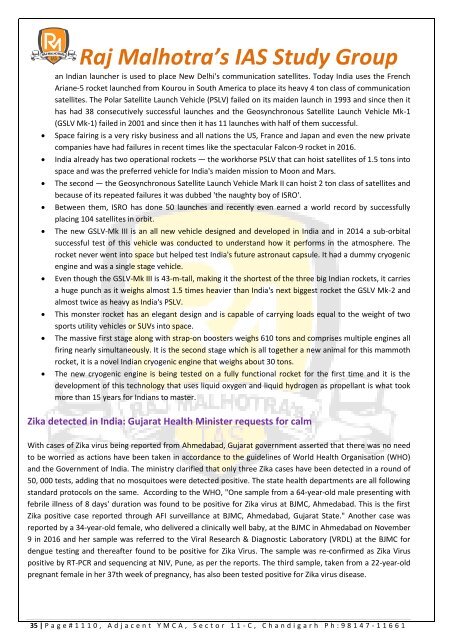Hard Facts 05 2017 (May)
You also want an ePaper? Increase the reach of your titles
YUMPU automatically turns print PDFs into web optimized ePapers that Google loves.
Raj Malhotra’s IAS Study Group<br />
an Indian launcher is used to place New Delhi's communication satellites. Today India uses the French<br />
Ariane-5 rocket launched from Kourou in South America to place its heavy 4 ton class of communication<br />
satellites. The Polar Satellite Launch Vehicle (PSLV) failed on its maiden launch in 1993 and since then it<br />
has had 38 consecutively successful launches and the Geosynchronous Satellite Launch Vehicle Mk-1<br />
(GSLV Mk-1) failed in 2001 and since then it has 11 launches with half of them successful.<br />
Space fairing is a very risky business and all nations the US, France and Japan and even the new private<br />
companies have had failures in recent times like the spectacular Falcon-9 rocket in 2016.<br />
India already has two operational rockets — the workhorse PSLV that can hoist satellites of 1.5 tons into<br />
space and was the preferred vehicle for India's maiden mission to Moon and Mars.<br />
The second — the Geosynchronous Satellite Launch Vehicle Mark II can hoist 2 ton class of satellites and<br />
because of its repeated failures it was dubbed 'the naughty boy of ISRO'.<br />
Between them, ISRO has done 50 launches and recently even earned a world record by successfully<br />
placing 104 satellites in orbit.<br />
The new GSLV-Mk III is an all new vehicle designed and developed in India and in 2014 a sub-orbital<br />
successful test of this vehicle was conducted to understand how it performs in the atmosphere. The<br />
rocket never went into space but helped test India's future astronaut capsule. It had a dummy cryogenic<br />
engine and was a single stage vehicle.<br />
Even though the GSLV-Mk III is 43-m-tall, making it the shortest of the three big Indian rockets, it carries<br />
a huge punch as it weighs almost 1.5 times heavier than India's next biggest rocket the GSLV Mk-2 and<br />
almost twice as heavy as India's PSLV.<br />
This monster rocket has an elegant design and is capable of carrying loads equal to the weight of two<br />
sports utility vehicles or SUVs into space.<br />
The massive first stage along with strap-on boosters weighs 610 tons and comprises multiple engines all<br />
firing nearly simultaneously. It is the second stage which is all together a new animal for this mammoth<br />
rocket, it is a novel Indian cryogenic engine that weighs about 30 tons.<br />
The new cryogenic engine is being tested on a fully functional rocket for the first time and it is the<br />
development of this technology that uses liquid oxygen and liquid hydrogen as propellant is what took<br />
more than 15 years for Indians to master.<br />
Zika detected in India: Gujarat Health Minister requests for calm<br />
With cases of Zika virus being reported from Ahmedabad, Gujarat government asserted that there was no need<br />
to be worried as actions have been taken in accordance to the guidelines of World Health Organisation (WHO)<br />
and the Government of India. The ministry clarified that only three Zika cases have been detected in a round of<br />
50, 000 tests, adding that no mosquitoes were detected positive. The state health departments are all following<br />
standard protocols on the same. According to the WHO, "One sample from a 64-year-old male presenting with<br />
febrile illness of 8 days' duration was found to be positive for Zika virus at BJMC, Ahmedabad. This is the first<br />
Zika positive case reported through AFI surveillance at BJMC, Ahmedabad, Gujarat State." Another case was<br />
reported by a 34-year-old female, who delivered a clinically well baby, at the BJMC in Ahmedabad on November<br />
9 in 2016 and her sample was referred to the Viral Research & Diagnostic Laboratory (VRDL) at the BJMC for<br />
dengue testing and thereafter found to be positive for Zika Virus. The sample was re-confirmed as Zika Virus<br />
positive by RT-PCR and sequencing at NIV, Pune, as per the reports. The third sample, taken from a 22-year-old<br />
pregnant female in her 37th week of pregnancy, has also been tested positive for Zika virus disease.<br />
35 | P a g e # 1 1 1 0 , A d j a c e n t Y M C A , S e c t o r 1 1 - C , C h a n d i g a r h P h : 9 8 1 4 7 - 1 1 6 6 1





